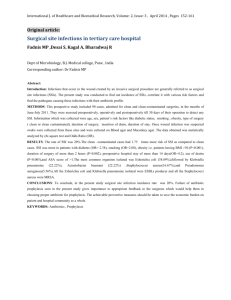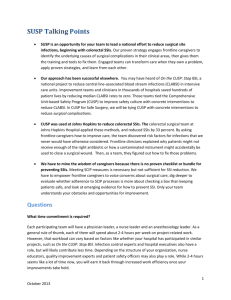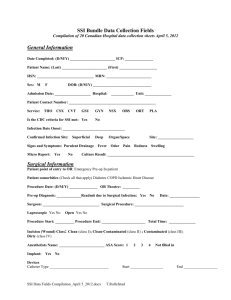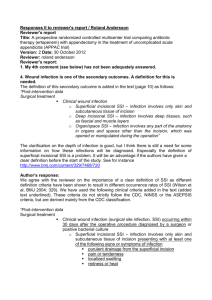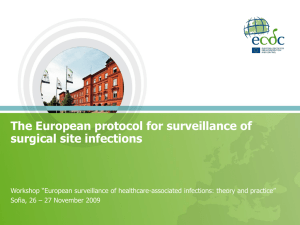Slashing SSI*s in Total Joints
advertisement
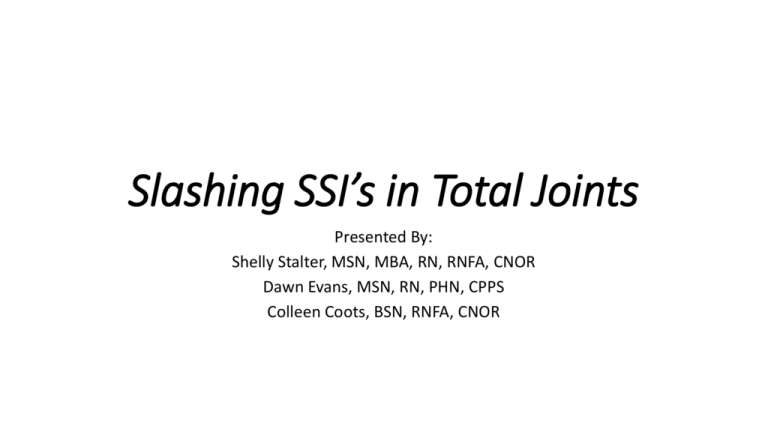
Slashing SSI’s in Total Joints Presented By: Shelly Stalter, MSN, MBA, RN, RNFA, CNOR Dawn Evans, MSN, RN, PHN, CPPS Colleen Coots, BSN, RNFA, CNOR Objectives • Relate the national costs and occurrence of total joint surgical site infections to Barton’s incidence rate. • Discuss strategies implemented to decrease total joint surgical site infections at Barton. • Analyze barriers encountered during Barton’s journey to decrease total joint surgical site infections. • Examine future endeavors to expand surgical site infection reduction strategies to Barton’s general surgical population. Barton Memorial Hospital South Lake Tahoe, CA Mission: Barton Health delivers safe, high quality care and engages the community in the improvement of health and wellness acute care hospital; 71 patient beds; 3-4 Operating rooms; 2900 surgeries per year with average 240 per month; 50% of surgical volume in orthopedics Surgical Site Infections (SSIs) • Healthcare Associated Infections (HAIs) continue to be a major patient safety issue • SSIs are one of the most prevalent HAIs • SSIs account for 31% of HAIs in hospitalized patients • Estimated 157,500 SSIs annually • Overall national SSI rate of 1.9% • 55% - 70% of SSIs are preventable with evidence based strategies • Total Joint SSIs estimate range of 0.9% - 2.5% annually • SSIs cause approximately 25% of revision joint surgeries • Estimated 20,000 total joint patients get an SSI Sources: Allen (2015), CDC (2015), Greene (2012), Institute for Healthcare Improvement (2012), Kapadia, Johnson, Issa, Naziri, Daley, Mont (2012) Surgical Site Infections (SSIs) • 3 Categories of SSIs: • Superficial Incisional SSI • Deep Incisional SSI • Organ Space SSI Source: CDC (2015) Superficial Incisional SSI • Occurs within 30 days after surgery • Involves only skin and subcutaneous tissue of the incision • At least one of the following exists: • Purulent drainage from incision • Positive culture • Incision deliberately opened by surgeon/physician • And patient has one of these signs/symptoms: • • • • Pain/tenderness Swelling Erythema Heat • Diagnosis of superficial SSI Source: CDC (2015) Deep Incisional SSI • Occurs within 30 to 90 days after surgery • Involves deep soft tissues of incision • Fascial and muscle layers • At least one of the following exists: • Purulent drainage • Dehiscence of deep incision • Deliberately opened/aspirated by physician • And patient has one of these signs/symptoms: • Fever (>38C) • Localized pain/tenderness • Abscess or other infection involving deep incision Source: CDC (2015) Organ Space SSI • Occurs within 30 to 90 days after surgery • Involves body part deeper than fascial/muscle layers • Which is opened/manipulated during surgery • At least one of the following exists: • Purulent drainage from drain in organ/space • Positive organ/space culture (fluid or tissue) • Abscess or evidence of infection involving organ/space Source: CDC (2015) Costs of Total Joint SSIs • Total Joint SSIs are a major financial burden: involves 3 types of costs • Medical Costs • Hospital readmissions • Treatments (antibiotics) • Additional surgical procedures (removal infected implants & revision joint procedure) • Indirect Costs • • • • Unreimbursed expenses – out of pocket Lost wages/productivity Increased morbidity Litigation • Intangible Costs • Emotional: pain/suffering • Psychological • Physical: daily activities Barton’s Total Joint SSI Rates SSI Comparison to National Rate 2013 SSI Investigation • 2013 – Infection Preventionist investigated SSIs • Director Surgery completed SSI worksheet • • • • Prophylactic antibiotics Patient skin prep Active warming OR staff not involved • SSIs continued • Staff education – SSIs, traffic, prepping, aseptic technique • SCIP measures were being met • October 2013 • Joined national SSI reduction program • SUSP – The Surgical Unit-Based Safety Program SUSP – Surgical Unit-Based Safety Program • Armstrong Institute for Patient Safety and Quality • Provided framework, education, and expertise • Create local safety culture • Team approach - multidisciplinary • • • • • • Surgeons Anesthesia Staff – OR, PACU, Pre-op, and Reprocessing Quality and Patient Safety Infection Preventionist Executive team How Did We Do It? • Front line staff involvement • Set reduction goal: Decrease total joint SSIs by 40% • Hospital Survey on Patient Safety • Perioperative Staff Safety Assessment • How will next patient in OR get an SSI? • How will next patient be harmed? • Assessment results categorized • Teams formed for each category • Staff and Patient Education • Infection Control Practices • Prophylactic Antibiotics • Audits • Traffic in/out TJ room • Prepping • Draping Back to Basics • Traffic Control • • • • • Traffic in/out TJ rooms excessive No Breaks (scrub or circ) Signs posted Staff education/evidence Continued Audits • OR Doors Closed • Open only for patients, equipment, supplies • Use substerile doors for access during cases • Education – why doors closed • Proper Surgical Attire Back to Basics (cont’d) • Patient Skin Prep • Following manufacturer’s instructions • Hair clipping in pre-op • Staff education/competency • Aseptic Technique Refresher • OR staff competency • Double gloving • Hand Hygiene • Active Warming • Begin warming in preop Prophylactic Antibiotics • Following SCIP Measures • Prophylactic antibiotics – 100% within one hour of incision • Correct antibiotic – 99% • Actively warmed – 100% • Antibiotic dosage • • • • Order sets not updated Ortho cases – dosing 1gm Cefazolin Surgeon education – SHEA guidelines Updated order sets - prophylactic antibiotic dosing Source: Barton Health (2014) Developed Total Joint SSI Bundle • Pre-op bathing – Chlorhexidine gluconate (CHG) • • • • 3 pre-op showers – 2 nights before, night before, morning of surgery Patient education Provide bathing kits CHG wipes in pre-op if non-compliant • MRSA Screening • Pre-op lab work • Consider decolonization if positive • Prophylactic Antibiotics • Based on SHEA Guidelines • OR Team Initiatives Barriers Encountered on our Journey • OR Team Culture • • • • Staff resistance Staff engagement Ownership of process We have always done it this way • Physician Support • Champions • Evidence-based initiatives • No clear evidence to support pre-op bathing with CHG • Vendors • Limit traffic in OR Future Endeavors for SSI Reduction • Goal for 2015 • 20% reduction of overall SSIs • Individual goals linked to departmental goal • Pre-op showering for all elective cases • Evidence non-supportive • New recommendation CDC & AORN • CHG cloths in pre-op • OR staff initiatives • • • • Aseptic technique Surgical attire Cleanliness of OR rooms Maintain traffic control • Repeat Hospital Survey on Patient Safety • Implement TeamSTEPPS References • Allen, G. (2015) Infection prevention: A patient safety imperative for the perioperative setting. Association of perioperative Nurses Journal, volume 101(5): 508-510 • Barton Health. (2014). Surgical quality ratings. Retrieved from http://www.bartonhealth.org/tahoe/surgical.aspx. Accessed June 1, 2015. • Centers for Disease Control and Prevention. (2015). Surgical site infection (SSI) event. Retrieved from http://www.cdc.gov/nhsn/PDFs/pscManual/9pscSSIcurrent.pdf?agre e=yes&next=Accept. Accessed May 25, 2015. References – cont’d. • Greene, L.R. (2012) Guide to the elimination of orthopedic surgery surgical site infections: An executive summary of the Association for Professionals in Infection Control and Epidemiology elimination guide. American Journal of Infection Control, Volume 40(4): pp. 384-386 • Institute for Healthcare Improvement (2012). How-to-guide: Prevent surgical site infection for hip and knee arthroplasty. Retrieved from http://www.ihi.org/resources/Pages/Tools/HowtoGuidePreventSSIfor HipKneeArthroplasty.aspx • Kapadia, B.H., Johnson, A.J., Issa, K., Naziri, Q., Daley, J.A., Mont, M.A. (2012) Prevention methodologies against infection after total joint arthroplasty. Current Orthopedic Practice, Volume 23(6): 533-539
